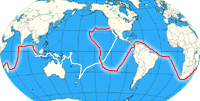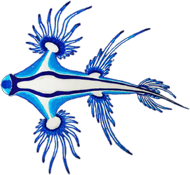On every street you drive on in Ascension you will see a very funny street sign: Attention Landcrabs! Those crabs are the only indigenous animals on land and live in the mountainous are of Ascension. The first ones we see are running across our path during a short walk. They look relatively small until we find out that those are juvenile ones since a grown one is suddenly sitting in our way. The shell or carapace is about 10 cm wide and they are colored orange-yellow. They can stay underground for weeks waiting for rain, then they appear en masse. We are lucky since it is a cloudy day and we get to see more of them, sometimes standing in the middle of the street looking at our car. Now we know why they need those traffic signs. It is weird for us to look for crabs so far away from the ocean where they normally live. This is a good example for evolution where animals develop in a free niche. In the mountains the climate for the landcrabs is much better than at the coast because it is raining more often and therefor more humid as well as there is more vegetation around for them to feed on. They are omnivorous which means they eat plants as well as animals, but mostly they feed on leaves, fruits and flowers. They even eat their discarded shell to conserve calcium. In the Atlantic Ocean this landcrab species Johngarthia lagostoma lives on three more islands, Trinidade, Fernando de Noronha and Atol das Rocas (all belonging to Brazil).
Those landcrabs live their whole life far away from the sea and even though they still have gills they have become especially adapted for breathing air. They quickly drown if they are submerged in water. Only once a year the females walk many kilometers towards the ocean to lay their eggs. They gather in huge numbers creating a most impressive wildlife spectacle. After about two to three weeks the baby landcrabs called 'megalops' emerge from the sea and go on their journey towards the mountains of Ascension.
The amount of landcrabs decreased in the 19th century. They were eaten as well as hunted and killed because of their habit to eat the crops on Green Mountain. For every hundred pairs of claws the person would get a reward in form of money. If the landcrab population has recovered is not known at the moment. Predators and competitors such as rats, mice and rabbits that were introduced to the island by humans, continue to threaten the future of the landcrabs. At least against the rats you can find lots of rattraps around the island.
The rats and before that also the cats were responsible for decreasing the huge numbers of seabirds breeding on the island. Before the arrival of humans there were millions of breeding pairs on the main island. But because of the introduced predators they vanished and were only able to breed on the big rock called Boatswain Island. There are 11 species of breeding seabirds on the island. Next to the endemic Ascension Frigatebird (Fregata aquila) you can also observe the Masked Booby (Sula dactylatra), the Brown Booby (Sula leucogaster) as well as the White or Fairy Tern (Gygis alba) quite regularly. Fairy Terns are very curious and often flew above our heads during our walks. We could even see some chicks of Brown Boobies at the Letterbox Peninsula. This is possible because of the feral cat control programme which was introduced in 2001. They were able to catch all the cats and so the island was declared cat free in 2006. The first seabirds breeding on the island were Boobies as well as the Brown Noddies (Anous stolidus) and the Yellow-billed Tropicbird (Phaeton lepturus). It took a little longer for the Ascension Frigatebird to come back. The first two nests were spotted in 2012 on the Letterbox Peninsula followed by 44 breeding pairs in 2014. The numbers will hopefully continue to rise and therefore cameras were installed to observe the birds closely.
Once a year huge numbers of Sooty Terns (Onchyprion fuscata) come into Mars Bay to form a big breeding colony. And at some point close to Ascension we also had a guest on board. An exhausted nocturnal Band-rumped Storm Petrel (Oceanodroma sp.) took a break during the night. They still can not breed on Ascension because of the high number of rats. But all the rat traps will hopefully take care of this problem.



_are_confined_to_the_mountainous_interior_with_higher_rainfalls.jpg)

.jpg)






.jpg)
_flying_at_Letterbox.jpg)


_is_endemic_and_nests_mainly_on_Boatswain_Island.jpg)
.jpg)


_are_also_called_Fairy_Terns_and_are_very_curious.jpg)
.jpg)
_is_nocturnal_and_visited_our_boat_during_the_night.jpg)

_enjoying_the_waves_at_English_Bay.jpg)
 >>planned route - join us ...
>>planned route - join us ...